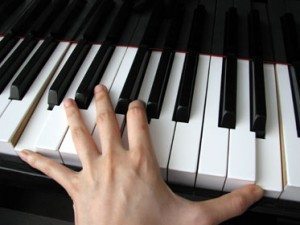

Piano Improvisation Idea #2: Happy-Sad-Happy A consistent pulse takes time and skill to develop. But don’t worry if it’s initially very free-form with little sense of metre. You should always give your student some parameters for their improvisation so that they feel safe to create. Right hand answers each note with a short phrase on the black keys. Left hand plays G flat for 4 beats and then E flat for 4 beats and repeats.Left hand plays a low G flat and the right hand answers it with a short phrase on the black keys.Hold down the pedal and play freely on the black keys.I recommend developing the solo version of the 4 x 4 improv in these stages: Once your student is comfortable doing this kind of piano improvisation duet with you, they might like to try going solo so they can continue to create at home.

Here’s a loose example of how this might come together: Solo Version While you play this accompaniment, your student can create their own music on the black keys. Repeat this several times and then hold the G flat major chord to finish.

Play this pattern with crotchet (quarter note) chords in your right hand and semibreve (whole note) root notes in your left hand: I call this one “4 x 4” because it consists of 4 chords played with a steady 4 beats in a bar. If I’m preaching to the choir and you want more advanced ways of using improvisation in piano lessons, there are loads of tips and tools on my Creative Skills hub page! Piano Improvisation Idea #1: Black Key 4 x 4 Try these 3 simple piano improvisation ideas with all your beginners and you’ll be creativity converts in no time.

Improvisation is one of the best things you can do with a new student to give them confidence in their own musicality and the freedom to explore the keys.Īny piano improvisation for beginners needs to be simple for 2 reasons:


 0 kommentar(er)
0 kommentar(er)
